Influence of Humidity on the Elastic Modulus and Axis Compressive Strength of Concrete in a Water Environment
Abstract
1. Introduction
- The elastic modulus of single strength grade concrete has been researched in previous studies, however, the sensitivity of elastic modulus affected by humidity conditions of concrete with different strength grades was different.
- In the physical experiment of concrete elastic modulus, the research range of humidity was mostly dry and saturated humidity conditions, and there was no intermediate transient excessive humidity condition.
- The humidity level was expressed in terms of water content in previous studies, but the water content was an absolute quantity. The proportion of pores in concrete filled with water could be expressed by the moisture content.
2. Experimental Materials, Equipment, and Design
2.1. Experimental Materials and Equipment
2.2. Experimental Design
3. Experimental Methods
4. Experimental Results and Analysis
4.1. Water Saturation of Concrete
4.2. Axial Compressive Strength of Concrete
4.3. Elasticity Modulus of Concrete
5. Discussion
- Physically free water A large number of pores and microcracks existed in the concrete, and the concrete elasticity modulus was weakened. When the concrete structure was in a nonpressurized water environment, the water entered the active pores of the concrete under the action of capillary adsorption force, and the active pores were filled by free water. Since the volume modulus of water was different from the matrix, the free water in the active pores of concrete impeded the deformation of the matrix, and the rigidity of the pores and microcracks were enhanced in the compressive elastic deformation stage under the external load. In addition, it can be seen from microhydrodynamics that the surface tension and viscous force of the water in the pores were both large, which contributed to the shear modulus of concrete in the elastic stage and ultimately the elasticity modulus of saturated concrete was enhanced. For completely dry concrete, pores and microcracks were filled with air and the elasticity modulus of air was very small, therefore the elasticity modulus of dry concrete was lower than the saturated concrete.
- Chemically combined water The main hydration product of cement paste was C-S-H, which accounted for 60–70% of the total volume of hydration product, and its deformation characteristics directly influenced the macroscopic deformation characteristics of concrete. According to Hou et al. [29], the molecular structure diagram of C-S-H in the dry and saturated state are shown in Figure 8. The influence of the number of water molecules on the deformation of C-S-H was analyzed based on the perspective of microscopic molecular structure.
6. Conclusions
- The water saturation of concrete increased with an extension in immersion time. The lower the strength grade of concrete, the faster its water absorption rate and the higher the water saturation reached under the same immersion time condition.
- The concrete axial compressive strength decreased with an increase in water saturation, and the effect of water saturation was significant. The axial compressive strengths of concrete with strength grades C15, C20, and C30, under approximate saturation, decreased by 27.2%, 21.1%, and 20.8%, respectively, as compared with the completely dry state. The concrete axial compressive strength with low-strength grade was more sensitive to the water saturation.
- The concrete elasticity modulus increased with an increase in water saturation. The elasticity moduli of concrete with strength grades C15, C20, and C30, under a saturated state, were 1.18, 1.19, and 1.24 times higher as compared with the completely dry state, respectively. The elasticity modulus of the concrete with high-strength grade was more sensitive to the water saturation, under the same water saturation condition.
Author Contributions
Funding
Acknowledgments
Conflicts of Interest
References
- Fang, X.Q.; Tian, J.Y.; Yang, S.P.; Li, B.L. Elastic–slip Interface Effect on Effective Elastic Modulus of Elliptical-fiber Reinforced Asphalt Concrete with Large Deformation. Arch. Civ. Mech. Eng. 2019, 19, 707–715. [Google Scholar] [CrossRef]
- Shao, H.Y.; Zhang, J.R.; Fan, T.Y.; Li, Z.J. Electrical Method to Evaluate Elastic Modulus of Early Age Concrete. Constr. Build. Mater. 2015, 101, 661–666. [Google Scholar] [CrossRef]
- Zhou, C.S.; Li, K.F.; Ma, F. Numerical and Statistical Analysis of Elastic Modulus of Concrete as a Three-phase Heterogeneous Composite. Comput. Struct. 2014, 139, 33–42. [Google Scholar] [CrossRef]
- Dalibor, K.B.K.; Petr, M.; Petr, Z.; Monika, K. Development of the Elastic Modulus of Concrete under Different Curing Conditions. Procedia Eng. 2017, 195, 96–101. [Google Scholar]
- Bian, L.C.; Wang, Q.; Meng, D.L.; Li, H.J. A Modified Micro-mechanics Model for Estimating Effective Elastic Modulus of Concrete. Constr. Build. Mater. 2012, 36, 572–577. [Google Scholar] [CrossRef]
- Emadaldin, M.G.; Ali, B. Application of Soft Computing Methods for Predicting the Elastic Modulus of Recycled Aggregate Concrete. J. Clean. Prod. 2018, 176, 1163–1176. [Google Scholar]
- Li, Z.L.; Deng, C.L.; Zhang, G.H. A Predictive Model of Effective Elastic Modulus of Concrete under Influence of Aggregate Gradation. J. Hydraul. Eng. 2016, 43, 108–144. [Google Scholar]
- Du, X.L.; Jin, L. Research on the Effective Modulus and Tensile Strength of Saturated Concrete. J. Hydraul. Eng. 2012, 43, 667–674. [Google Scholar]
- Dong, W.G.; Liu, C.L.; Bao, X.B.; Xiang, T.F.; Chen, D.P. Advances in the Deformation and Failure of Concrete Pavement under Coupling Action of Moisture, Temperature, and Wheel Load. Materials 2020, 13, 5530. [Google Scholar] [CrossRef]
- Cao, M.B. The Discussion of the Influence of the Mix Proportion of Concrete with Concrete Elastic Modulus. Bull. Sci. Technol. 2012, 28, 195–197. [Google Scholar]
- Li, L. Study on the Influence of Water Content on Concrete Performance; Beijing Jiaotong University: Beijing, China, 2009. [Google Scholar]
- Bjerkeli, L.; Jensen, J.; Lenschow, R. Strain Development and Static Compressive Strength of Concrete Exposed to Water Pressure Loading. Aci. Struct. J. 1993, 90, 310–315. [Google Scholar]
- Mori, K.; Uebayashi, K.; Fujikake, K.; Ohno, T.; Satoh, H. Influence of Moisture Content on Compressive and Tensile Strength Properties of Concrete under High Strain-rates. J. Struct. Eng. A 2001, 47, 1673–1681. [Google Scholar]
- Davis, R.E.; Troxell, G.E. Modulus of Elasticity and Poisson’s Ratio for Concrete, and the Influence of Age and Other Factors upon These Values. Proc. Am. Soc. Test. Mater. 1929, 29, 678–710. [Google Scholar]
- Johnston, C.D. Concrete and Its Constituent Materials in Uniaxial Tension and Compression; Queens University of Belfast: Belfast, Northern Ireland, 1967. [Google Scholar]
- Van der Wegen, G.; Bijen, J.; Van Selst, R. Behaviour of Concrete Affected by Sea-water under High Pressure. Mater. Struct. 1993, 26, 549–556. [Google Scholar] [CrossRef]
- Yaman, I.O.; Hearn, N.; Aktan, H.M. Active and Non-active Porosity in Concrete Part I: Experimental Evidence. Mater. Struct. 2002, 35, 102–109. [Google Scholar] [CrossRef]
- Yaman, I.O.; Hearn, N.; Aktan, H.M. Active and Non-active Porosity in Concrete Part II: Evaluation of Existing Models. Mater. Struct. 2002, 35, 110–116. [Google Scholar] [CrossRef]
- Liu, B.D.; Lv, W.J.; Li, L.; Li, P.F. Effect of Moisture Content on Static Compressive Elasticity Modulus of Concrete. Constr. Build. Mater. 2014, 69, 133–142. [Google Scholar] [CrossRef]
- Wang, H.L.; Li, Q.B. Experiments of the Compressive Properties of Dry and Saturated Concrete under Different Loading Rates. J. Hydroelectr. Eng. 2007, 26, 84–89. [Google Scholar]
- Hou, D.W.; Zhang, J.; Chen, H.Y.; Liu, W. Development of Strength and Elastic Modulus of Concrete under Moisture and Drying Curing Conditions. J. Hydraul. Eng. 2012, 43, 198–208. [Google Scholar]
- Wu, S.; Chen, X.; Zhou, J. Influence of Strain Rate and Water Content on Mechanical Behavior of Dam Concrete. Constr. Build. Mater. 2012, 36, 448–457. [Google Scholar] [CrossRef]
- Rossi, P.; Van Mier, J.G.M.; Boulay, C. Effect of Loading Rate on the Strength of Concrete Subject to Uniaxial Tension. Mater. Struct. 1994, 27, 260–264. [Google Scholar] [CrossRef]
- Zhang, G.H.; Li, X.H.; Li, Z.L. Experimental Study on Static Mechanical Properties and Moisture Contents of Concrete under Water Environment. Sustainability 2019, 11, 2962. [Google Scholar] [CrossRef]
- Rossi, P.; Boulay, C. Influence of free water in concrete on the cracking process. Mag. Concrete. Res. 1990, 42, 143–146. [Google Scholar] [CrossRef]
- National Development and Reform Commission. Chinese Standard. In DL/T5330-2005 Code for Mix Design of Hydraulic Concrete; China Standards Press: Beijing, China, 2005. [Google Scholar]
- Ministry of Water Resources of the People’s Republic of China. Chinese Standard. In SL352-2006 Hydraulic Concrete Test Procedure; China Standards Press: Beijing, China, 2006. [Google Scholar]
- Sun, J.Y. Research Moisture Transport under Wetting and Drying Conditions; Zhejiang University: Hangzhou, China, 2012. [Google Scholar]
- Hou, D.S.; Ma, H.Y.; Yu, Z.B.; Li, Z.J. Calcium Silicate Hydrate from Dry to Saturated State: Structure, Dynamics and Mechanical Properties. Acta Mater. 2014, 67, 81–94. [Google Scholar] [CrossRef]
- Hu, C.L.; Ruan, Y.X.; Yao, S.; Wang, F.Z.; He, Y.J.; Gao, Y.Y. Insight into the Evolution of the Elastic Properties of Calcium-silicate-hydrate (C-S-H) Gel. Cem. Concr. Comp. 2019, 104, 103342. [Google Scholar] [CrossRef]
- Hou, D.S.; Zhao, T.J.; Ma, H.Y.; Li, Z.J. Reactive Molecular Simulation on Water Confined in the Nanopores of the Calcium Silicate Hydrate Gel: Structure, Reactivity, and Mechanical Properties. J. Phys. Chem. C 2015, 119, 1346–1358. [Google Scholar] [CrossRef]
- Hou, D.S.; Li, D.K.; Zhao, T.J.; Li, Z.J. Confined Water Dissociation in Disordered Silicates Nanometer-channels at Elevated Temperatures: Mechanism, Dynamics and Impact on the Substrates. Langmuir ACS J. Surf. Colloids 2016, 32, 4153–4168. [Google Scholar] [CrossRef]
- Hu, C.L.; Han, Y.G.; Gao, Y.Y.; Zhang, Y.M.; Li, Z.J. Property Investigation of Calcium–silicate–hydrate (C–S–H) Gel in Cementitious Composites. Mater. Charact. 2014, 95, 129–139. [Google Scholar] [CrossRef]
- Hu, C.L.; Gao, Y.Y.; Chen, B.M.; Zhang, Y.M.; Li, Z.J. Estimation of the Poroelastic Properties of Calcium-silicate-hydrate (C-S-H) Gel. Mater. Des. 2016, 92, 107–113. [Google Scholar] [CrossRef]
- Hou, D.S.; Lu, Z.Y.; Zhao, T.J.; Ding, Q.J. Reactive Molecular Simulation on the Ordered Crystal and Disordered Glass of the Calcium Silicate Hydrate Gel. Ceram. Int. 2016, 42, 4333–4346. [Google Scholar] [CrossRef]

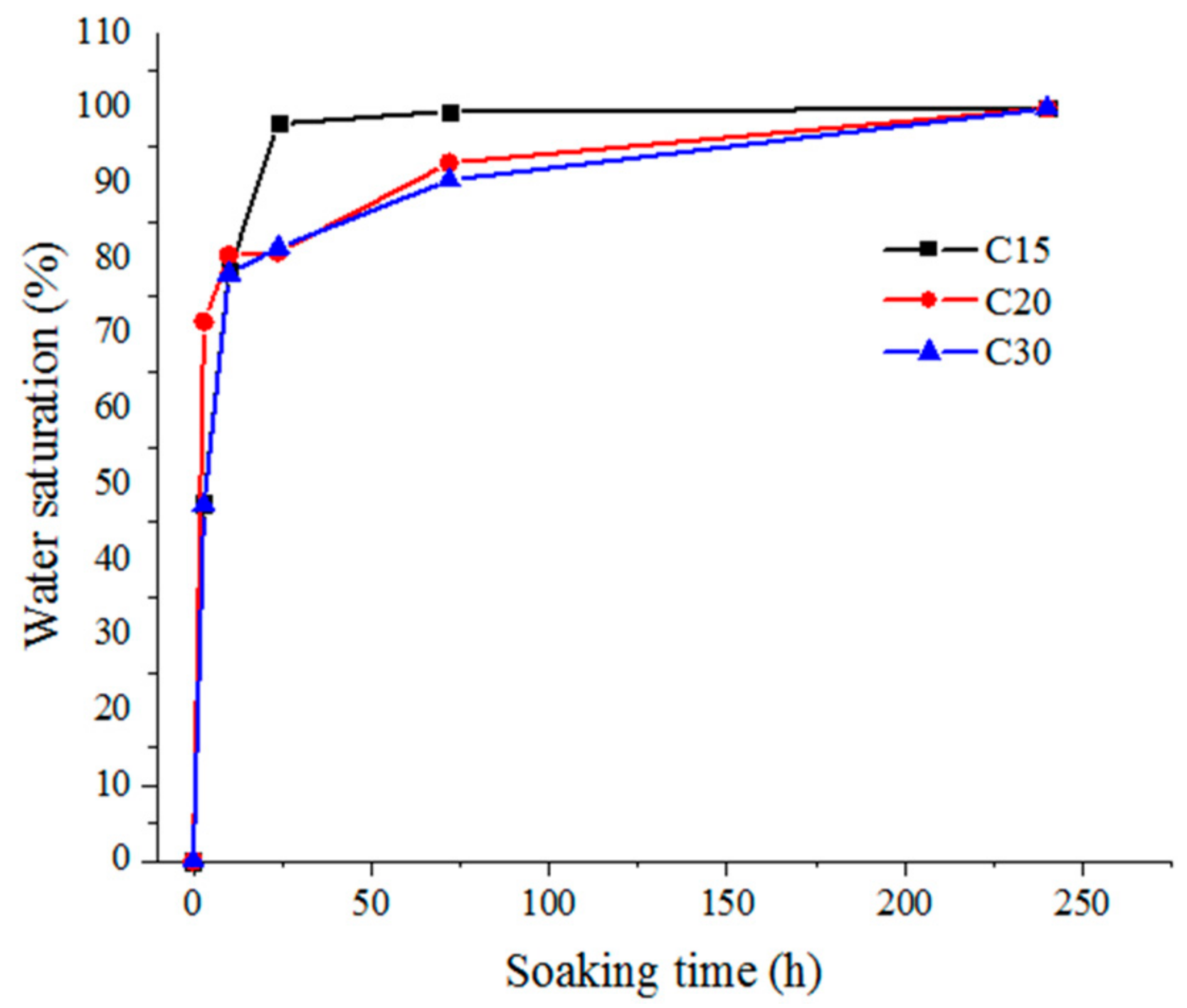


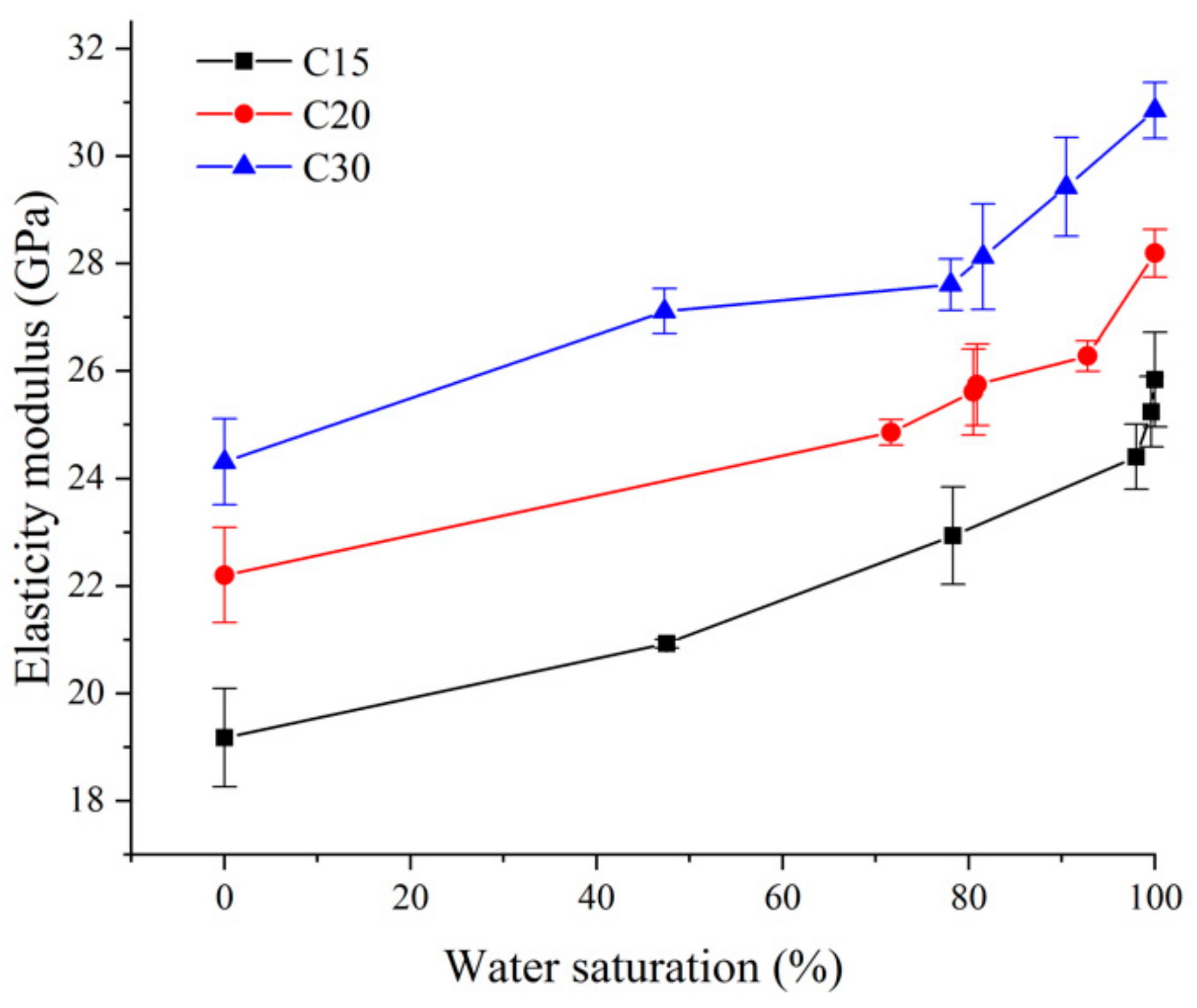
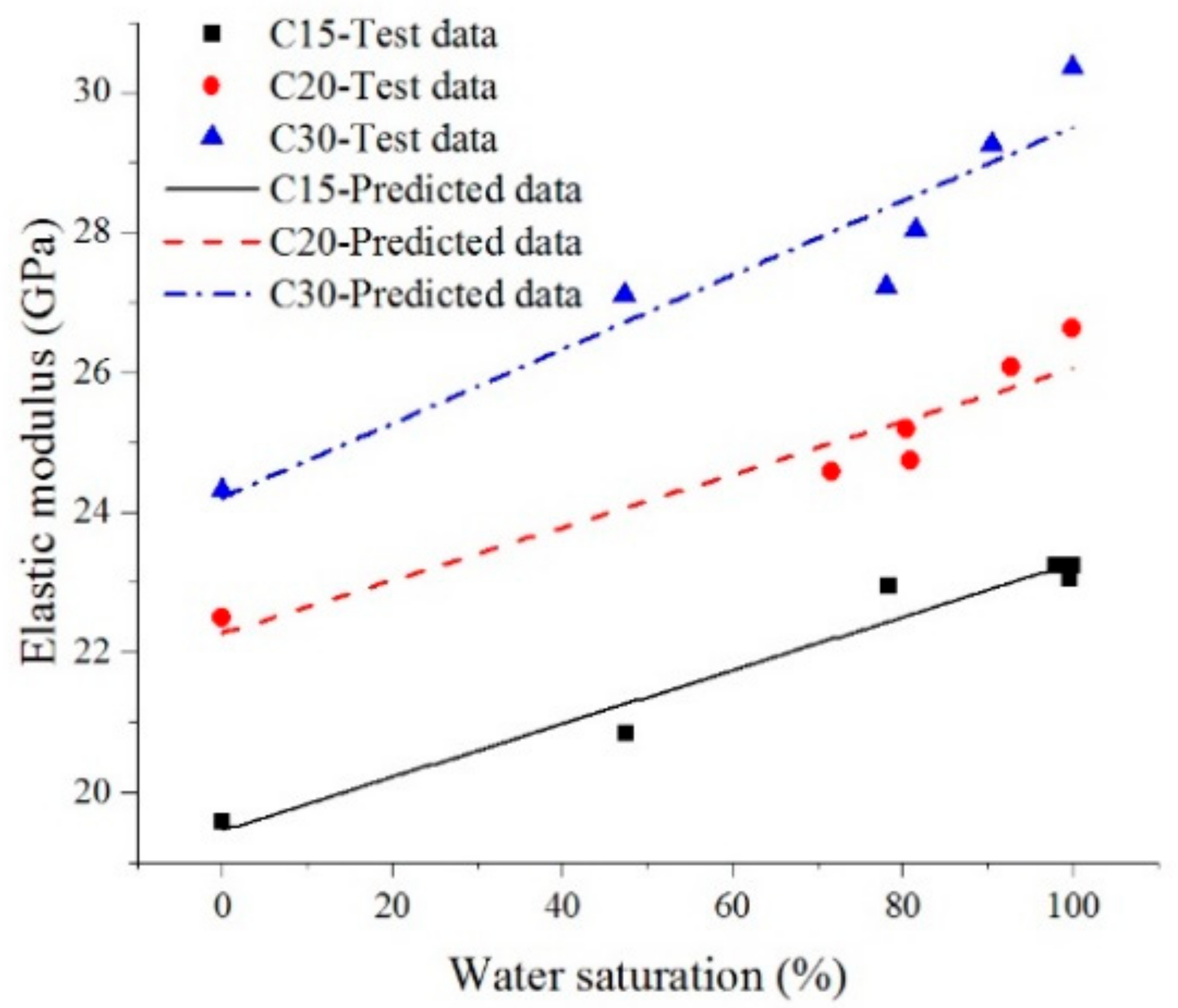
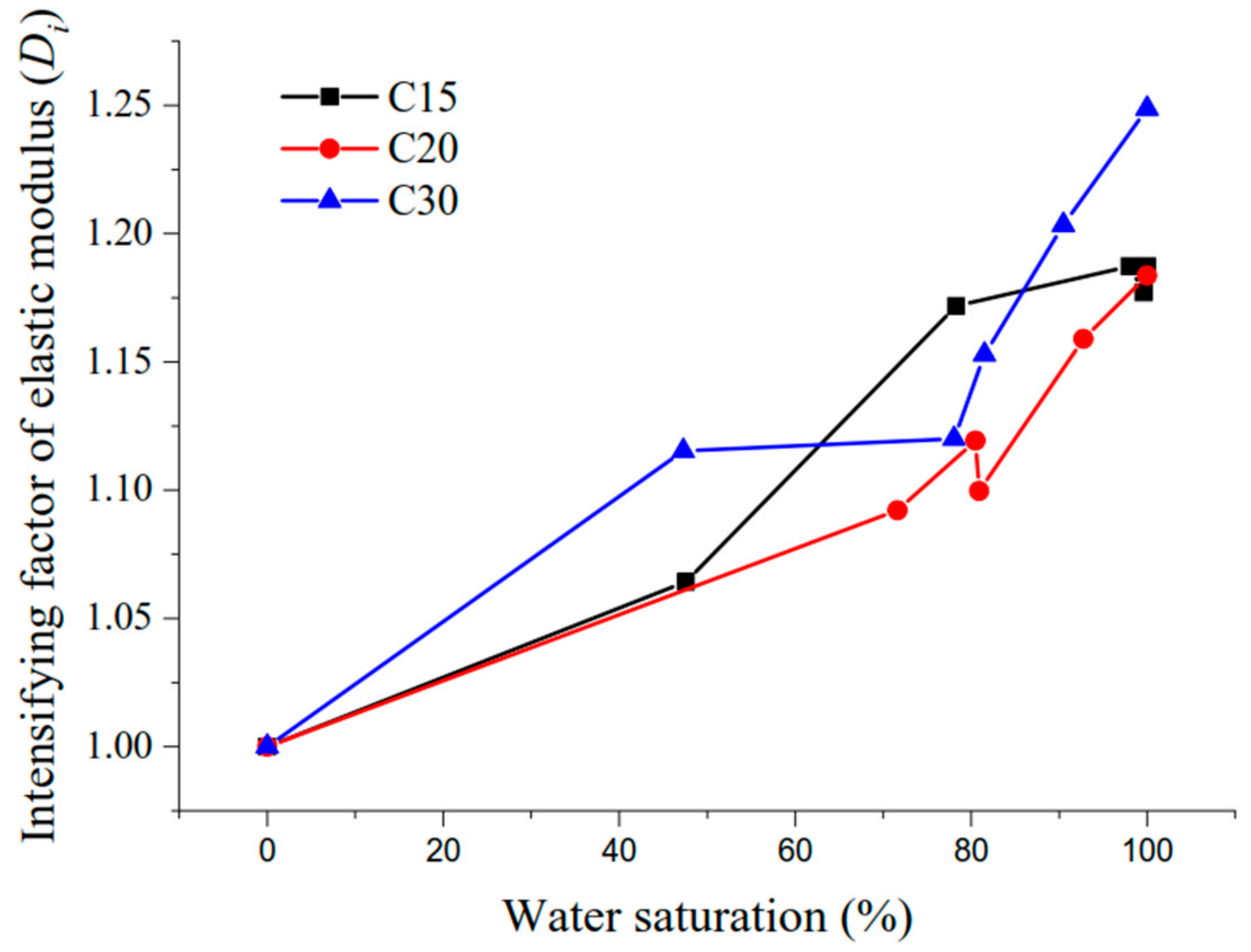
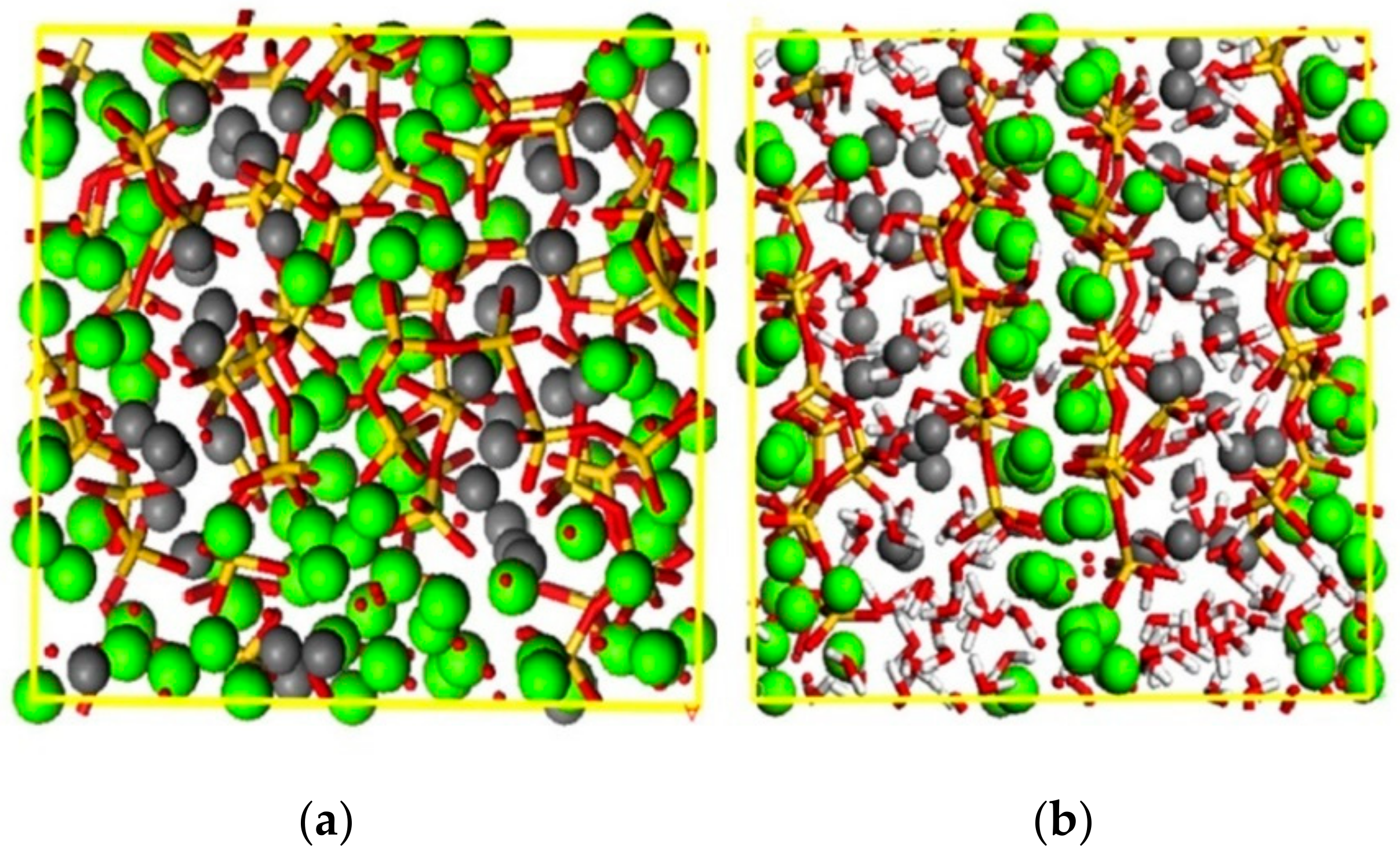
| Strength Grade | Water/Cement Ratio | Mix Proportion/kg·m−3 | ||||
|---|---|---|---|---|---|---|
| Water | Cement | Medium Sand | Small Stone | Middle Stone | ||
| C15 | 0.65 | 158 | 243 | 729 | 709 | 709 |
| C20 | 0.55 | 150 | 273 | 615 | 685 | 685 |
| C30 | 0.42 | 165 | 391 | 581 | 646 | 646 |
| Strength Grade | Completely Dry Group | Soaking Time/h | ||||
|---|---|---|---|---|---|---|
| 3 | 10 | 24 | 72 | 240 | ||
| C15 | A0 | A1 | A2 | A3 | A4 | A5 |
| C20 | B0 | B1 | B2 | B3 | B4 | B5 |
| C30 | C0 | C1 | C2 | C3 | C4 | C5 |
| C15 | C20 | C30 | |||
|---|---|---|---|---|---|
| Water Saturation/% | Axial Compressive Strength/MPa | Water Saturation/% | Axial Compressive Strength/MPa | Water Saturation/% | Axial Compressive Strength/MPa |
| 0.00 | 16.41 | 0.00 | 21.48 | 0.00 | 28.29 |
| 47.56 | 14.87 | 71.63 | 19.85 | 47.29 | 26.67 |
| 78.30 | 13.30 | 80.48 | 18.55 | 78.05 | 24.45 |
| 97.99 | 12.45 | 80.90 | 17.75 | 81.51 | 23.50 |
| 99.59 | 12.07 | 92.75 | 17.33 | 90.48 | 23.31 |
| 100 | 11.94 | 100 | 16.94 | 100 | 22.42 |
| C15 | C20 | C30 | |||
|---|---|---|---|---|---|
| Water Saturation/% | Elastic Modulus/GPa | Water Saturation/% | Elastic Modulus/GPa | Water Saturation/% | Elastic Modulus/GPa |
| 0 | 19.58 | 0 | 22.50 | 0 | 24.31 |
| 47.56 | 20.83 | 71.63 | 24.58 | 47.29 | 27.12 |
| 78.30 | 22.94 | 80.48 | 25.19 | 78.05 | 27.23 |
| 97.99 | 23.24 | 80.90 | 24.75 | 81.51 | 28.03 |
| 99.59 | 23.04 | 92.75 | 26.08 | 90.48 | 29.26 |
| 100 | 23.24 | 100 | 26.63 | 100 | 30.36 |
| Strength Grade | Model Parameter | ||
|---|---|---|---|
| C15 | 0.038 | 19.45 | 0.96 |
| C20 | 0.037 | 22.27 | 0.90 |
| C30 | 0.052 | 24.27 | 0.89 |
| Water Saturation Si/% | Predicted Value by Equation (4) Elasticity Modulus/GPa | Tested Value Reference [19] Elasticity Modulus/GPa | Relative Error/% |
|---|---|---|---|
| 0.00 | 24.27 | 25.01 | −2.97 |
| 35.14 | 26.10 | 27.59 | −5.42 |
| 75.68 | 28.21 | 29.82 | −5.42 |
| 72.97 | 28.06 | 29.80 | −5.81 |
| 100.00 | 29.47 | 32.47 | −9.23 |
Publisher’s Note: MDPI stays neutral with regard to jurisdictional claims in published maps and institutional affiliations. |
© 2020 by the authors. Licensee MDPI, Basel, Switzerland. This article is an open access article distributed under the terms and conditions of the Creative Commons Attribution (CC BY) license (http://creativecommons.org/licenses/by/4.0/).
Share and Cite
Zhang, G.; Li, C.; Wei, H.; Wang, M.; Yang, Z.; Gu, Y. Influence of Humidity on the Elastic Modulus and Axis Compressive Strength of Concrete in a Water Environment. Materials 2020, 13, 5696. https://doi.org/10.3390/ma13245696
Zhang G, Li C, Wei H, Wang M, Yang Z, Gu Y. Influence of Humidity on the Elastic Modulus and Axis Compressive Strength of Concrete in a Water Environment. Materials. 2020; 13(24):5696. https://doi.org/10.3390/ma13245696
Chicago/Turabian StyleZhang, Guohui, Changbing Li, Hai Wei, Mingming Wang, Zhendong Yang, and Yanshuang Gu. 2020. "Influence of Humidity on the Elastic Modulus and Axis Compressive Strength of Concrete in a Water Environment" Materials 13, no. 24: 5696. https://doi.org/10.3390/ma13245696
APA StyleZhang, G., Li, C., Wei, H., Wang, M., Yang, Z., & Gu, Y. (2020). Influence of Humidity on the Elastic Modulus and Axis Compressive Strength of Concrete in a Water Environment. Materials, 13(24), 5696. https://doi.org/10.3390/ma13245696





